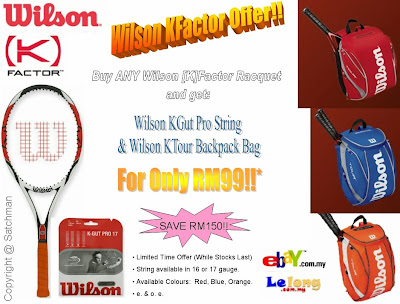News |
Reviews |
Tips |
Buy |
Email Us
Sometime last year, I did a quick demo of the
Babolat Aeropro Drive, Pure Drive, Pure Drive Plus and Pure Drive Cortex. Compared to my trusted
Wilson nCode 6.1 95, the Babolat's were much easier to play with because of the increase in power and the lower swingweight (in most cases).
Here was my 2 cents worth from the short demo...
.jpg) 1) Aeropro Drive (APD):
1) Aeropro Drive (APD):A
very stable racquet. Didn’t expect the hits to feel this nice on a Babolat. Although at a hefty
300 grams, it didn’t feel heavy and had a headlight balance. Power was there and I was able to rip through the ball with spin and depth.
Even without the Cortex or a dampener, I could feel very little vibration on impact. I didn’t get much chance to volley or serve with the racquet but this was definitely on my short list!
 2) Pure Drive (PD) Team:
2) Pure Drive (PD) Team: Another sweet racquet with a
tad more power than the APD. The racquet was slightly more
head heavy than the APD and suited my flat style of play.
In the beginning I was having trouble controlling the power compared to the nCode but once I got my timing right and added a touch of spin, I was able to hit with good depth and placement. It’s so much easier to play with this racquet compared to the nCode. The swingweight was less and I was able to generate good racquet head speed, even when late receiving a hard-hit shot. Slice definitely was a plus because it caught my stroking partner out a few times.
Serving was excellent using the PD. The nCode is a lovely racquet to serve with but it just takes so much effort. With the PD I could hit a flat serve, spin it, slice it, etc with accuracy and much less effort.
My
volleys were a little wayward due to the power of the racquet but I guess it just takes time to get used to it. Also, I tried the PD with and without the dampener and wow, without the dampener, the vibrations are bad. Not enough to cause tennis elbow but enough to be annoying…
All in all, I was happy with this racquet.
3) Pure Drive Plus (PD+):Actually, I didn’t realise I was using this because the coach had switched the PD for this in the middle of the demo. I found the racquet had a
much heavier swingweight and felt as heavy (if not more heavy) than my nCode. I was hitting the balls as hard as the PD and I found no problems in timing. I was finding though, that I was tiring fast using this racquet.
At first I attributed the feel and weight to a change in strings but once the coach told me it was the Plus version, then I realised why there was this difference.
Serving was again excellent with the PD+ and I didn’t find any difficulty with the swingweight or extra length of the PD+. Perhaps I was used to my nCode’s heavier swing weight?
Again, I didn’t get to volley much with the PD+ but with that added swingweight, I would think that it wouldn’t be as good as the PD.
All in all, contrary to what the coach believed, I was more impressed with the PD as it felt a lot easier to handle.
 4) Pure Drive Cortex (PDC):
4) Pure Drive Cortex (PDC):I spotted this in the coach’s bag and asked for a demo (it was his personal one so I guess he was worried about me damaging it or something). But he let me try it and thank goodness he did because
this was the pick of the bunch for me.
Same excellent power and control as the PD but with
none of that annoying vibration. I used the PDC without any dampener and the feel at impact was as sweet as my nCode.
Again, it was so
easy to generate pace and spin with this racquet and was much less work than my nCode. At this point in the demo, my stroking partner was hitting powerful, deep shots and I was getting them back with some venom, with much less effort than my nCode.
Conclusion:So the 2 finalists were the Aeropro Drive and Pure Drive Cortex. It was very hard to differentiate the two and the Nadal marketing campaigns were working on me… but then again so were the Roddick and Moya ones! So…
… the thing was that I felt the
PDC more suited my style of play –
4.0 all-court, flat hitting 2 hander, who plays mainly doubles. So I guess the PDC would be my pick of the bunch.

 News
News |
Reviews |
Tips |
Buy |
Email Us
 I'm Tom and I am an Online Sports Retailer of:
I'm Tom and I am an Online Sports Retailer of:










.jpg)



